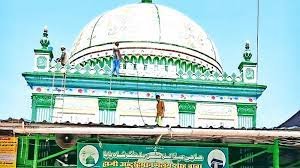Maharashtra Chief Minister Eknath Shinde has pledged to liberate the centuries-old Haji Malang Dargah. Right-wing groups claim the dargah is a temple.
A day after Maharashtra Chief Minister Eknath Shinde said he is committed to the “liberation” of the centuries-old Haji Malang Dargah, which right-wing groups say is a temple, the off-grid shrine in Thane district was abuzz with activity, but not due to the storm that has built around it.
On the lowest plateau of Malanggad, a hill fort 3,000 feet above sea level in the Matheran hill ranges, the dargah is preparing for the death anniversary of Yemeni Sufi saint Haji Abd-ul-Rahman, known as Haji Malang Baba.
Few followers who made the two-hour climb to the Sufi saint’s final resting place were aware of the recent dispute.
“Anyone claiming that the dargah is a temple is doing it for political mileage,” said Chandrahas Ketkar, one of the two trustees of the three-member trust whose family has managed it for 14 generations.
He claimed that in 1954, the Supreme Court ruled in a Ketkar family case that the dargah was a composite structure that could only be controlled by its own specific custom or general law of trusts. Politicians are raking it up to appeal to their vote bank and create a political issue.
The shrine, which many feel represents Maharashtra’s syncretic culture, has been controversial. The 1980s campaign began with Shinde’s political mentor Anand Dighe’s claim that the edifice was the site of a Nath Panth yogi temple.
Shinde has revived the topic after the Shiv Sena put it on hold in the 1990s.
The 1882 Gazetteers of Bombay Presidency mentions the dargah. It states the shrine honors Arab missionary Haji Abd-ul-Rahman, known as Haji Malang. While Nal Raja was king, the Sufi saint and his followers from Yemen resided on the hill’s lower plateau.
Many traditions surround the dargah, including Nal Raja marrying his daughter to the Sufi saint. Haji Malang and Maa Fatima are buried in the dargah.
The Bombay Presidency Gazetteers says the structure and burials date to the 12th century.
The hereditary guardians of the dargah, local Muslims, objected to a Brahmin managing it in the 18th century. The local administrator chose in 1817 to find the saint’s will by “casting lots” in this control dispute, not the shrine’s religious aspect.
The Gazette reports that Kashinath Pant’s representative won three times and was declared guardian.
As hereditary trustees of the Haji Malang Dargah Trust, the Ketkars have maintained the shrine. Hindus and Muslims worked together in the trust.
Conclusion
Maharashtra Chief Minister Eknath Shinde has pledged to liberate the centuries-old Haji Malang Dargah, which right-wing groups call a temple. The Thane area off-grid shrine is preparing for the death anniversary of Yemeni 12th-century Sufi saint Haji Abd-ul-Rahman. The composite dargah on Malanggad’s lowest level cannot be ruled by Hindu or Muslim law but by its own custom or trust law. Three-member trust trustee Chandrahas Ketkar says political leaders are digging up the matter to appeal to their vote bank and create a political problem. In the 1980s, Shinde’s political instructor Anand Dighe led a dargah protest. The dargah and burials date to the 12th century.




